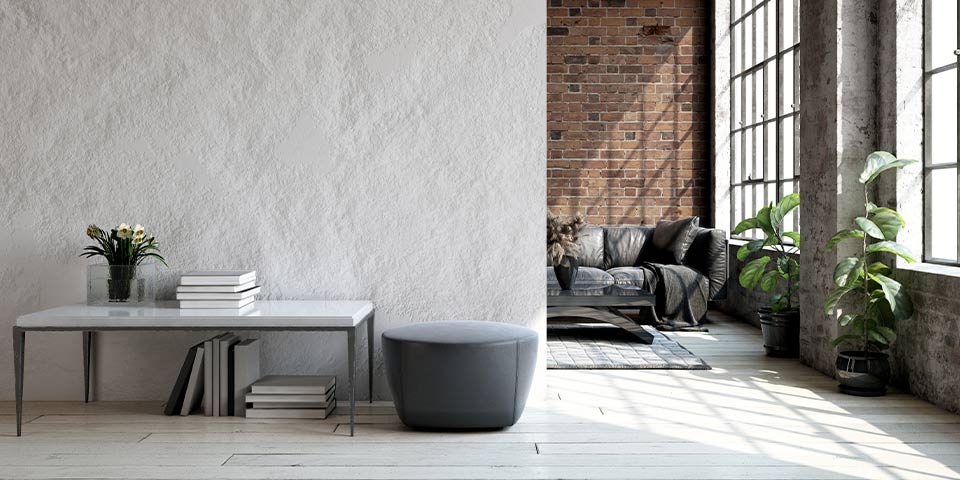How to Clean and Restore Exposed Brick Walls

Exposed brick walls are known for giving a warm, rustic look to the living rooms, bedrooms, and kitchens that they adorn.
But brick walls that are crumbling and cracked have the opposite effect. Not something you want. But don’t worry: cleaning and restoring the brick in your exposed brick wall is a simple DIY project. Here’s how!
Repair Damaged Mortar
In order to repair the damaged mortar between the bricks, you will essentially have to chisel away the old, cracked mortar and repoint the spaces by adding fresh mortar. Repointing your brick wall helps to not only improve the appearance of the wall but also strengthens the stability of the structure. Make sure to put on your safety goggles and mask; this project can produce a lot of dust.
Step 1: Chisel away loose or damaged mortar.
Use a hammer and flat chisel to chip away the old mortar from between the bricks to a depth of between 1/2-inch and 1-inch. Make sure you chisel carefully as you don’t want to chisel the actual brick itself. Clean out the cavity using a wire brush and then moisten the brick with water.
Step 2: Mix masonry mortar.
Following the instructions accompanying the masonry mortar, blend the mixture in a bucket. Using a brick trowel, place the mortar into any gaps between the brick starting with the vertical joints first and then the horizontal joints. Following this pattern will help you avoid damaging the structural integrity of the brick’s surface.
Step 3: Wipe away excess mortar.
Wipe any excess mortar that may have made it to the face of the brick away using the edge of the trowel and/or a moist rag.
Step 4: Seal the surface.
After repointing the mortar, you’ll want to seal the surface to make sure that the fresh mortar lasts as long as possible by preventing water damage. Use a sealant with a matte finish rather than a glossy finish to maintain the authentic texture of the brick.
Cleaning Your Exposed Brick Wall
After the mortar has dried completely, you can move on to cleaning your brick. The rough texture and fragile composition of brick can make it a bit of a challenge to clean. Abrasive cleaning methods can damage the brick and mortar, particularly if the brick is old. Harsh cleaning chemicals can discolor the brick, making the wall look worse than when you started.
The best cleaning method is using a mixture of equal parts dishwashing detergent and table salt. Stir the ingredients together to form a paste-like consistency.
Prior to rubbing the paste on the brick surface, dust the wall using a feather duster or vacuum to remove visible dust and cobwebs. Old rags with lint or paper products tend to leave behind more dust and debris on the brick than when you started.
Using your hands or a wet rag, rub the cleaning paste over the brick working in small sections. Scrub the brick using a stiff bristled scrub brush then wipe away the paste with a rag and warm water. Repeat the process of applying the paste, scrubbing with a brush, and rinsing away the cleaner across the entire brick wall.
Wait for the wall to dry then check the results. If the wall is clean, job well done! If there are still patches of dirt on the brick, then use a cleaner that is tougher on dirt. Warm water alone is typically sufficient in cleaning exposed brick but if the wall is particularly dirty, then the dish detergent and table salt mixture can cut through grease and stains. Apply it to the brick and let it sit for about 10 minutes before using the brush to scrub away the dirt.
Prepare to Paint Your Exposed Brick Wall
If you have chosen to paint your exposed brick wall, and have already consulted our article “Should I Paint My Brick Wall?” then it’s time to paint!
The best paint for both exterior and interior brick is acrylic latex because it resists moisture penetration while also providing a permeable coating that allows water vapor to escape. This makes the wall highly resistant to mildew and moisture while still allowing the brick to breathe, a necessity for a healthy brick structure.
Conclusion
We hope that this has been a helpful guide in cleaning and preparing your brick wall for paint. You can also check out our guide on different ways to update your interior brick here! If you have any other questions or are going to be building in the Virginia Beach and Hampton Roads area, we offer a wide variety of fired bricks and non-fired bricks for your next project! Call 757-625-2506 or use our contact page today!
Enjoy Your Backyard All Fall Long

Now is the perfect time to take advantage of autumn’s mild days to prepare your backyard for the cold months ahead. But who’s to say you can’t still enjoy your backyard, spending time with your family, and cooking outdoors all fall long.
"*" indicates required fields




